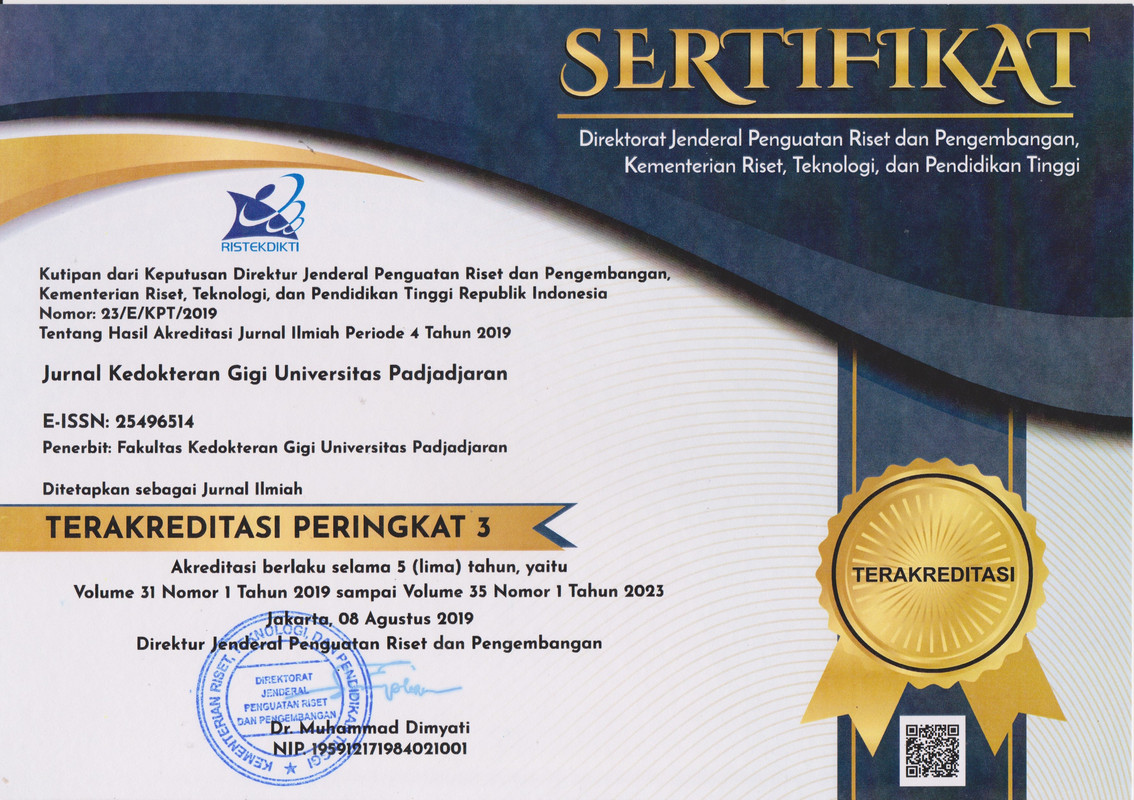Perbedaan pH saliva antara wanita hamil dan tidak hamil
The difference of salivary pH in pregnant and non-pregnant women
Abstract
Pendahuluan: Saliva merupakan cairan mulut yang terdiri atas komponen organik dan anorganik dan berperan penting dalam lingkungan rongga mulut. Kehamilan dapat mempengaruhi saliva, salah satunya berpengaruh pada pH saliva. Wanita hamil biasanya mengeluhkan mulut terasa asam. Penelitian ini bertujuan untuk mengetahui perbedaan pH saliva antara wanita hamil dan tidak hamil di Puskesmas Jatinangor. Metode: Penelitian ini bersifat observasi dengan desain analitik. Subjek penelitian terdiri atas 30 wanita hamil dan 30 wanita tidak hamil yang dipilih dengan metode purposive sampling yang berada di Puskesmas Jatinangor. Unstimulated saliva dikumpulkan untuk menentukan nilai pH saliva. Data dianalisis dengan independent two sample t-test dengan α = 0,05. Hasil: Hasil penelitian menunjukkan nilai signifikansi 0,000 (p<0,01). pH saliva wanita hamil lebih rendah daripada pH saliva wanita tidak hamil dengan rata-rata pH saliva wanita hamil 6,519 dan rata-rata pH saliva wanita tidak hamil 7,192. Penurunan pH saliva terjadi karena peningkatan kadar hormon progesteron yang menyebabkan penurunan konsentrasi ion bikarbonat (HCO3-), dan peningkatan enzim amilase, serta seringnya wanita hamil mengonsumsi makanan manis dan/atau asam. Simpulan: Terdapat perbedaan pH saliva antara wanita hamil dan tidak hamil, dimana pH saliva wanita hamil lebih rendah daripada pH saliva wanita tidak hamil.
Kata kunci: Kehamilan, pH saliva, unstimulated saliva.
ABSTRACT
Introduction: Saliva is an oral fluid consisting of organic and inorganic components which plays an essential role in the oral environment. Pregnancy can affect saliva, one of which affects the pH of saliva. Pregnant women usually complain that their mouth feels sour. This study was aimed to determine the difference in salivary pH between pregnant and non-pregnant women at Jatinangor Community Health Centre. Methods: This research was observational with analytic design. The research subjects consisted of 30 pregnant women and 30 non-pregnant women who were selected by the purposive sampling method at Jatinangor Community Health Center. Unstimulated saliva was collected to determine the pH value of saliva. Data were analysed by independent two-sample t-test with α = 0.05. Result: The results of the study showed a significance value of 0.000 (p < 0.01). The salivary pH of pregnant woman was lower than the salivary pH of non-pregnant woman with an average salivary pH of 6.519 for pregnant woman and an average salivary pH of 7,192 for non-pregnant woman. A decrease in salivary pH occurred because of an increase in the level of the progesterone hormone which also causes a decrease in the concentration of bicarbonate ions (HCO3-), and an increase in amylase enzymes, and the frequency of pregnant women consuming sweet and sour foods. Conclusion: There was a difference in the salivary pH between pregnant and non-pregnant women as indicated by the salivary pH of pregnant women which was lower than the salivary pH of non-pregnant women.
Keywords: Pregnancy, salivary pH, unstimulated saliva.
Keywords
Full Text:
PDFReferences
Karnik AA, Pagare SS, Krishnamurthy V, Vahanwala SP, Waghmare M. Determination of salivary flow rate, pH, and dental caries during pregnancy: A study. J Indian Acad Oral Med Radiol. 2015; 27(3): 372-6. DOI: 10.4103/0972-1363.170454
Cunningham FG, Leveno KJ, Bloom SL, Spong CY, Dashe JS, Hoffman BL dkk. Williams Obstetrics. 24th ed. New York: McGraw-Hill Education/Medical; 2014. h. 182-9.
Beckmann CRB, Ling FW, Barzansky BM, Herbert WNP, Laube DW, Smith RP. Obstetrics and Gynecology. 6th ed. Philadelphia: Wolters Kluwer Health/Lippincott Williams & Wilkins; 2010. h. 43-55.
Sultana R, Zafarullah SN, Kirubamani H. Saliva signature of normal pregnant women in each trimester as analyzed by FTIR spectroscopy. Indian J Sci Tech. 2011; 4(5): 481-6. DOI: 10.17485/ijst/2011/v4i5/30046
Naveen S, Asha MI, Gurudath S, Bajoria A, Jose AA. Salivary Flow Rate, pH and Buffering Capacity in Pregnant and Non Pregnant Women - A Comparative Study. J Nepal Dent Assoc. 2013; 13(2): 84-9.
Jain K, Kaur H. Prevalence of oral lesions and measurement of salivary pH in the different trimesters of pregnancy. Singapore Med J. 2015; 56(1): 53-7. DOI: 10.11622/smedj.2015010
Hemalatha VT, Manigandan T, Sarumathi T, Aarthi Nisha V, Amudhan A. Dental considerations in pregnancy-A critical review on the oral care. J Clin Diagn Res. 2013; 7(5): 948-53. DOI: 10.7860/JCDR/2013/5405.2986
Gupta R, Acharya AK. Oral health status and treatment needs among pregnant women of Raichur District, India: A population based cross-sectional study. Scientifica (Cairo). 2016; 2016: 9860387. DOI: 10.1155/2016/9860387
Saluja P, Shetty V, Dave A, Arora M, Hans V, Madan A. Comparative evaluation of the effect of menstruation, pregnancy and menopause on salivary flow rate, pH and gustatory function. J Clin Diagn Res. 2014; 8(10): ZC81-5. DOI: 10.7860/JCDR/2014/9935.5071
Kamate WI, Vibhute NA, Baad RK. Estimation of DMFT, salivary Streptococcus mutans count, flow rate, pH, and salivary total calcium content in pregnant and non-pregnant women: A prospective study. J Clin Diagn Res. 2017; 11(4): ZC147-ZC151. DOI: 10.7860/JCDR/2017/24965.9516
Wong DT. Salivary diagnostics. Oper Dent. 2012; 37(6): 562-70. DOI: 10.2341/12-143-BL
Tortora GJ, Defrickson B. The respiratory system. Principles of anatomy and physiology. 13th ed. USA: John Willey & Sons; 2013. h. 893-4.
Lasisi TJ, Ugwuadu PN. Pregnancy related changes in human salivary secretion and composition in a Nigerian population. Afr J Med Med Sci. 2014; 43(4): 347-51.
White D, Matthew D. The hormone makeover. Florida: Xulon Press; 2010. h. 322.
Ozturk LK, Akyuz S, Garan A, Yarat A. Salivary and dental - oral hygiene parameters in 3rd trimester of pregnancy and early lactation: The effect of education. Marmara Dent J. 2013; 1(1): 1-8.
Direktorat Jenderal Bina Upaya Kesehatan. Pedoman pemeliharaan kesehatan gigi dan mulut ibu hamil dan anak usia balita bagi tenaga kesehatan di fasilitas pelayanan kesehatan. Jakarta: Kementerian Kesehatan Republik Indonesia; 2012. h. 5-11.
Skośkiewicz-Malinowska K, Kaczmarek U. The level of salivary α-amylase activity during pregnancy. Dent Med Probl. 2013; 50(1): 30-7.
Ingber A. Obstetric dermatology: A practical guide. Berlin: Springer Science & Business Media; 2009. h. 40-2.
Vyas A, Vyas D, Parakh D, Rajput R, Mazumdar U, Purohit C. Management of HIV/Hepatitis Patients in Oral and Maxillofacial Surgery. Int J Prev Clin Dent Res. 2014; 1(3): 42-7.
DOI: https://doi.org/10.24198/jkg.v31i1.17234
Refbacks
- There are currently no refbacks.
Copyright (c) 2019 Jurnal Kedokteran Gigi Universitas Padjadjaran
INDEXING & PARTNERSHIP

Jurnal Kedokteran Gigi Universitas Padjadjaran dilisensikan di bawah Creative Commons Attribution 4.0 International License






.png)
















